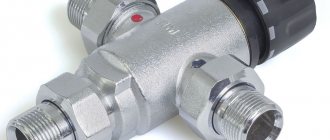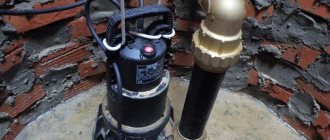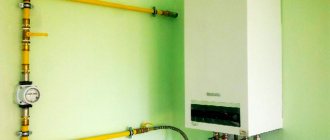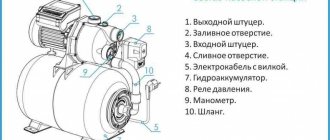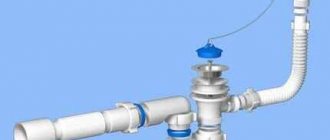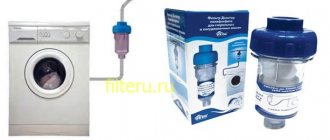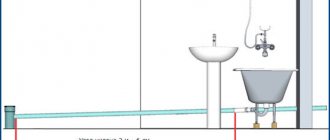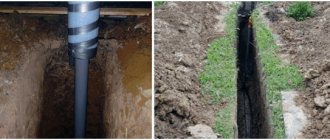Everything you wanted to know about the fan pipe is in this article.
We will tell you in detail whether a sewer pipe is needed for a private house or whether you can do without it. Let's consider the need for its installation in one-story, two-story and apartment buildings, with a septic tank, cesspool and central sewer system.
- Is a vent pipe needed in a one-story private house?
- Is a drain pipe necessary in a house with a septic tank?
- Fan pipe in an apartment building
- Is a drain pipe needed in a private house with central sewerage?
- conclusions
general description
A sewer system is a network of channels for transporting wastewater from a source to a collection point. The system also contains vertical elements that do not come into contact with liquids—fan pipes. Let's consider what it is.
Purpose
To understand what a fan pipe is, it’s easier to understand why it is needed. The sewerage system usually involves the presence of several channels, which are reduced to a single one with a large diameter. To ensure that the liquid leaves the source by gravity, a slope is provided and a riser is installed. Inside the latter, during the flow of water from several points at once, a kind of vacuum is formed. Because of this, rarefaction appears, which causes reverse movement of the liquid (suction).
The second unpleasant thing that is typical for sewage systems is the smell. If there is no water seal (a curved section filled with water) in the area of collection points, then “fragrant” air from inside the system penetrates into the room. To eliminate this phenomenon and the formation of a vacuum, a ventilation duct is installed inside the riser, which is the fan pipe.
Connecting a background channel without installing a riser Source odstroy.ru
Device
The ventilation device for the waste system is usually represented by a straight channel. A vertical pipe is installed outside the interior of the house to prevent odors from penetrating into the premises. This is usually done through the roof and roofing material with a distance of about 300 mm from it. The top is protected from clogging by a special lining (deflector). In multi-storey buildings, the drain pipe is a continuation of the riser. In a private sector with one floor, the gas exhaust channel starts either from one side of the transition node between the street and the room, or in the area of convergence in the maximum number of branches.
The principle of operation of the gas outlet is to ensure atmospheric pressure inside the communication. It changes naturally due to the downward movement of liquid and the upward movement of light gases. The latter are formed during the biological decay of organic substances. Air does not get inside the room due to the water seal, so it rushes along the path of least resistance along the riser and drain pipe.
Example of a siphon with a water seal Source sagittarius.sk
Varieties
It is clear that the drain pipe is a ventilation element of the sewer system. Therefore, the main requirement for products can be considered resistance to corrosion and various types of chemical reagents. The cross section is often selected by analogy with the diameter of the riser, if the channel is its continuation. In the private sector, it is allowed to use gas exhaust pipes with a cross-section reduced by half. As a rule, the choice is limited to 50 mm. But this is only permissible in the case of a riser of the same size. Narrowing the highway is technically unacceptable.
Today, for the installation of a sewer gas outlet, 2 types of products are selected based on the material:
- Cast iron.
Once upon a time, thick-walled metal, proven in practice, with its characteristic durability and mechanical strength, was popular in the urban and private sector. The ability to dampen vibration and sound also stands out. But due to the heavy weight and low ductility of the material, most users and craftsmen try to replace metal with analogues of a different nature.
Another disadvantage is that such pipes can only be installed with a sewerage system made of a similar material, as other channels simply will not withstand the weight load from a riser with a waste gas outlet.
Cast iron sewer section Source zemkadastr45.ru
- Steel.
This material is rarely used. It is chosen, as a rule, if unnecessary sections remain from the installation of a particular pipeline. The metal is characterized by durability and, compared to cast iron, lighter weight. However, there are a number of disadvantages. These include the ability to conduct vibrations without damping them, and the propagation of sound with its increase.
Craftsmen also note the difficulty of forming sealed joint connections between steel blanks and a plastic or cast iron channel. The reason is the need to use special shaped products.
- Plastic.
Polymer products today are in great demand in the construction market due to their low weight, ease of processing, and versatility in application. The plastic material is able to withstand mechanical loads and temperature operating conditions that are characteristic of the gas outlet channel of the sewerage system.
Another plus is the wide range and variety of fittings that can be installed without special equipment. Here it is easy to select the required diameter to extend a cast-iron or other riser.
Plastic drainage system in a private house Source makler.md
Another difference between sewerage pipes lies in the design. They can be straight or offset. The former are characterized by rigidity, the latter are made corrugated. The latter is relevant when providing ventilation for toilets, which are manufactured with different shapes and outlet positions.
See also: Catalog of companies that specialize in engineering systems (heating, water supply, sewerage and others) and related work
Design
To carry out the correct installation of this air duct, you first need to take care of drawing up the project. Such a project must meet two requirements that must be taken into account in all cases without exception:
- installation of the pipe is carried out in the direction of the removal of sewer gases using the force of the wind;
- the pipe for the ventilation riser should have a cross-sectional index no larger than that of the sewer riser.
Installing a vent riser is a necessary step in most cases and is carried out by connecting a pipe to the ventilation duct. In some cases, such installation cannot be performed and the outlet is made through the wall.
The system by which sewer vapors are removed includes the following structural elements:
- fan pipes;
- connecting pipes;
- ventilation ducts;
- connecting elements (fittings).
The future vent riser is attached to the drain pipe using adapter fittings
Justification for installing a drain pipe
After finding out what a fan pipe is, you need to understand its necessity. For apartment buildings, a gas outlet for sewerage is an undeniable necessity. Let's consider the relevance of channels in the case of private houses.
Technical necessity
The ventilation element in the drainage system helps equalize the pressure inside the sewer. Due to the volumetric flow, the water seals are torn off or emptied, so odors freely enter the building through the siphons. That is, technically, the output of the background channel is necessary in the following cases:
- high probability of simultaneous use of several bathrooms;
An example with at least three bathrooms Source 6cotok.boltai.com
- the sewer system includes horizontal channels that are connected to at least three sources of waste;
- risers are assembled from pipes with a diameter of 50 mm;
- the close location of the septic tank in an autonomous sewer system, according to the regulations this distance is less than 8 meters;
- the presence of a swimming pool and other sources that provide for the installation of several drain points.
Houses higher than two floors are built less frequently in the private sector. A common riser is installed here. In this case, a gas outlet device is also required.
There are two ways to check the presence or absence of a fan system in an old house. There is no gas outlet channel if, after draining the water from the toilet, the water seal is immediately emptied. Also, a characteristic squelching sound is heard in the siphons. On the top floor, a sign of the presence of ventilation is a riser that goes through the ceiling.
Opinion of dissenting laymen
Paper will endure anything, and intangible media even more so. The Internet is filled with strange kinds of texts, from which the reader “learns” that:
- Allegedly, SNiP contains a direct indication of the need to install a ventilation valve in all houses without exception.
- The valve supposedly removes odors.
Undoubtedly, a specialist or just a person who imagines what a ventilation valve is will immediately recognize the obvious stupidity of such texts. Non-specialists, on the contrary, risk damaging their sewer lines due to an understandable reluctance to make a hole in the roof of their own house.
Video description
This video demonstrates the consequences of the absence of a drain pipe and explains how this happens:
Acceptable reasons for non-use
The most obvious reason for refusing to install a drainage channel is a small one-story house with a minimum number of sources of waste water. With a greater height, the building should be provided with a riser with a diameter of 110 mm. This is enough to use the bathtub and toilet at the same time. In the case of an autonomous septic tank located nearby, the pipe can be replaced with a vent valve.
Example of a vent valve Source rus-line.com
Fence mount
Attaching the hood to a fence or similar durable fence is a non-standard solution for creating ventilation. It is almost the same as mounting on the walls of a building. The only difference is that the ventilation ducts are located further from the house and more material will be required for the work.
Pipeline fastening varies depending on the design features of the support. On cast fences it is better to use steel support brackets suspended on dowels. To fix it on the fence made of corrugated sheets, you will have to prepare a welding machine.
Features of installation
It’s clear what a sewer drain pipe is. Is its installation always technically necessary? We figured it out. Let's look at how to properly install a gas exhaust duct.
Requirements for the sewerage element
Regardless of the type of communication, any engineering system must meet a number of technical requirements. The same applies to its individual elements. Thus, the vent gas outlet in the sewer must meet the following criteria:
- Section.
The diameter of the drain pipe in a building with several bathrooms (toilet, bathtub, shower) must be equal to or greater than the cross-section of the widest section in the network.
- Location.
The type of roof can be continuous or exploitable. In the first case, the ventilation protrusion is formed with a height of 300-500 mm, in the second - 3 meters. If the roof structure includes windows or balconies, then a minimum distance of 4 m is maintained.
Another height limitation concerns the presence of other pipes near the channel. To prevent gases from entering the ventilation or chimney, it is enough to erect the fan gas outlet 150 mm higher than the others. Experts also recommend choosing a site for draining the canal on the leeward side.
An example of close placement of different pipes Source forumdubna.ru
- pommel.
The upper end must not be covered with decorative items. This can cause ice to form in winter. For the drain pipe, there are suitable options for deflectors that can protect the channel from clogging and natural precipitation. These can be umbrella elements or filter attachments.
Since the vent pipe acts as a gas outlet, there is an opinion that the duct can be connected to the general ventilation of the house. However, this event is technically unacceptable. This is justified by the fact that in the general house network the air moves in both directions. This means the smell from the sewer will spread inside the building. It is also forbidden to connect to a stove chimney. Here the reason is the formation of condensation inside the pipe, which negatively affects draft.
Installation recommendations
It is better to start installing the vent pipe in a heated room. The withdrawal must be carried out outdoors. This way the system will work more efficiently in terms of equalizing the pressure inside the pipeline.
According to SNiP 30.13330 of 2012, it is recommended to form a gas outlet to the riser in a straight vertical line. There are situations when it is necessary to extend the channel along a curve.
Design of a curved background channel Source ark-eng.ru
For example, you need to shift the outlet relative to the window, or combine several gas outlets from complex sewer sections into one. Then turns at right angles are excluded. It is acceptable to use fittings with a rotation of 15, 30, 45 or 87 degrees.
Regarding the assembly of the structure, you should adhere to the following tips from the craftsmen:
- In order to reliably seal node connections taking into account vibration loads, sealants, metal clamps with a rubber seal are used, additional fixation of elements along the entire length to load-bearing walls or other structures is performed (rigid at pipe joints, floating in straight sections in increments of 1-1.5 m );
- to prevent the formation of condensation, smudges, and ice, each element used is positioned with the socket facing up, and the next one is inserted into it;
- sections of the gas exhaust duct outside the heated part of the house must be insulated; installation of sound insulation inside the room is recommended.
An example of sewer soundproofing Source stroy-podskazka.ru
External ventilation
A direct alternative to an internal ventilation system is the method of placing ventilation ducts outside the building. Mostly it is done in already built houses.
Along the outer wall
The channel is laid along the load-bearing wall in the form of a special box installed at the junction. Next, install an outlet that turns the pipe at an angle of 90, so the ventilation will turn from a horizontal position vertically upward.
The pipe is attached to the wall with support brackets; they must be placed at a maximum interval of 2 m. The top of the pipe is raised above the lower edge of the roof. During installation, it is required to maintain a minimum space of indentation from windows (4 m) and similar structural elements of the building.
Aerators
A vacuum valve is a compact device that is designed to perform the same tasks as a sewer drain pipe. In the private sector, the device is an effective alternative to a gas exhaust channel. The most important advantage of the aerator is that it is located on a riser only indoors. That is, the integrity of the floor, roof and roof is not compromised.
The operating principle of the vacuum valve is based on automatic displacement of the membrane. If there is a lack of air in the serviced network due to vacuum, the plastic element made of silicone or rubber moves, freeing up the passage of an additional portion. When the pressure in the channel is restored, the membrane returns to its place, thereby creating an obstacle to the penetration of odors and gases into the room.
Vacuum aerator disassembled Source autozem.ru
Despite the usefulness and simplicity of the compact device, experts pay attention to 2 of its disadvantages. If operating pressure is maintained in the sewer riser for a long time, the polymer membrane “sticks” to the seat. It is impossible to detect this until the water seals begin to suffer or the smell begins to penetrate into the house.
The second disadvantage is the nature of the elastic membrane. Poor quality polymer products dry out over time and lose their desired shape. The same thing happens from frequent operation. As a result, the deformed element is not able to fully prevent the passage of gases and odors into the room.
A vacuum valve is often unknowingly confused with a non-return valve. The second belongs to the group of shut-off pipe fittings. The design has a cylindrical shape and a built-in lid. A device is installed in the area where the toilet is connected to the sewer system. During draining, the lid opens; as the water stops flowing, it closes due to the mechanical tension of the spring attached to it. The tightness of the overlap is ensured by rubber gaskets-rings.
Operating principle of a non-return valve for sewerage Source santehmarka.ru
Design and principle of operation
Before you go to the store to make a purchase, you need to understand how the mechanism works and become familiar with the design.
There is nothing complicated in the design of a vacuum valve.
Do you know how to choose and buy a fecal pump for a cesspool? This useful article contains advice from simple plumbers. Find out what to look for when inspecting the device.
Read everything you need to know before buying cross-linked polyethylene pipes for heating here.
On the page: it is written how you can make a tabletop fountain with lighting and fog with your own hands.
The unit is very simple and consists of the following elements:
- Fixture frame.
- A small special opening that is designed to allow air to enter the body of the mechanism.
- Rod . This component responds to the pressure difference that occurs inside the sewer system.
- Gasket made of especially durable rubber . With its help, smooth movement of the rod is ensured, and it also limits the movement of the rod.
- Cap designed to protect the elements located inside the valve from dirt and dust.
Briefly about the main thing
A drain pipe is a sewer ventilation element that works with air masses and does not come into contact with wastewater.
The channel is designed to equalize the atmospheric pressure in the riser during the active use of several sources of wastewater or the passage of a large volume of liquid through the sewer system, for example, from a swimming pool.
A gas outlet is installed, as a rule, on top of a riser with a similar diameter (narrowing is unacceptable), then the channel is led out onto the street, preferably in a straight line through the ceiling, roof and roof.
For the fan system, cast iron, steel or plastic blanks can be used.
It is recommended to soundproof part of the gas outlet inside the living space, and insulate the outside of the heated space.
According to building regulations, the installation of a drain pipe is not always necessary, especially in the case of small and one-story houses.
As an alternative to a channel passing through structures, a vacuum valve can be installed, which is compact, does not pass inside walls or ceilings, and does not require additional insulation.
The disadvantages of a vacuum valve come down to the short service life of the rubber or silicone membrane inside the housing.
Ratings 0
Ventilation of the septic tank
Any treatment plants should be located no closer than 5 m from the building. This way, harmful fumes containing toxic components will not penetrate into the rooms. Ventilation of the septic tank is created during the design of the installation. It is also necessary for the effective operation of bacteria that decompose wastewater.
Fan ventilation is often used for this; it freely supplies fresh air and also does not allow vacuum to occur in the container when a large volume of liquid is discharged. In addition to the exhaust pipe, the installation of fresh air ventilation is required. It is assembled from several pipes, placing them near the treatment device and raising them 0.5-1 m from the soil level.
Output to the roof
Not everyone knows how to ventilate the roof. This must be done, since the ventilation system in the attic cannot end. The drainage pipe must have access to the roof so that there is a connection with the street and the atmosphere. If the sewer is led to the attic, then all the unpleasant odors will be concentrated there. When the hood does not reach the roof, mold will begin to appear in the attic as a result of increased humidity, which will cause a lot of harm to the entire home. The fan pipe is installed both on the roof of a multi-story building and a single-story building.
What to do when the drain pipe on the roof freezes? To prevent it from freezing on the roof, it is necessary to provide insulation around it. The cause of freezing is the formation of condensation, since warm air tends to rise. The result is freezing of the walls with ice, which can lead to the blocking of the exhaust lumen and the cessation of the functioning of the entire system.
The risers are insulated with rolled heat insulators or “shells”, which should be securely fastened.
In some cases, it is impossible to carry out the drainage pipe to the roof. This is not a problem, since you can use a horizontal mounting scheme for the exhaust system. The end of the ventilation system will not be located on the roof, but will be vented through the wall into the air.
You can buy a roof vent pipe at a construction supermarket.
Important! Regardless of how the drain pipe is routed - onto the roof or through the wall, the system requires a check valve.
In order for ventilation systems to function for a long time and efficiently, when laying pipelines, you must adhere to the above-mentioned norms and rules. Only then will your home not be filled with unpleasant odors, but will constantly feel the flow of fresh air.
Use of cast iron elements
For several decades, the installation of exhaust ducts took place using cast iron risers. Today, cast iron fan pipes are becoming increasingly rare. But in vain, because using risers made of this material you can be sure of the quality of the exhaust and ventilation ducts. Cast iron parts have a number of advantages.
They differ:
- strength. The rigidity and density of the alloy contribute to the safe operation of cast iron products, which can be purchased at a hardware store. They are used in the construction of private, multi-storey buildings;
- long service life. This is due to high wear resistance, which helps metal products maintain excellent technical characteristics for many years;
- resistance to mechanical impacts. They are not afraid of accidental impacts, damage, or heavy loads.
Minuses:
- tendency to corrosion processes;
- difficulty of transportation;
- heavy weight;
- high price.
When repairing or replacing old cast iron risers, it is necessary to dismantle the existing system. It is not easy to do this if the sewer or exhaust line is located in a hard-to-reach place. How to disassemble a cast iron pipe behind a toilet? It is difficult to carry out this procedure if tow with cement, aluminum or sulfur were used to connect the risers.
First you need to dismantle the parts that are located further from the riser. To do this, you should stock up on a chisel or a hammer with a plastic or rubber head. When you hit the chisel with an iron hammer, pieces of metal sharply bounce off the pipe and can fall into the riser, since cast iron is a very brittle alloy.
Having completed all the preparatory work, proceed to removing the cast iron drain or sewer riser:
- After destroying this element of the system, gradually approach the crosspiece, leaving 30-35 cm of an almost broken part.
- Using the remaining piece, gently loosen it. If this does not help, then use a chisel to start removing the packing, loosen it again, and then remove the remaining fragment.
- If the system is sealed with sulfur, then you need to take a blowtorch or gas torch and start heating the packing. Before doing this, you need to cover the furniture and walls with a screen so as not to damage them. It is advisable to carry out this work together, since one person must remove the heated, viscous sulfur.
- After removing a certain amount of the heated mass, remove the remainder of the unnecessary part of the part.
An option is possible when you can use a grinder to cut off the rest of the line right up to the socket. This procedure will ensure not only a neat cut, but also a quick, convenient joining of the new plastic sewer part with the old cast iron riser.
Important! The cast iron fan pipe can be used in any extreme situations. This means that such a system will function normally under conditions of a wide temperature range at elevated pressure.
Work with cast iron sewer or sewer pipes, including drilling them, must be carried out with the utmost care. This is due to the increased fragility of the metal.
Over a long period of operation, as a result of corrosion processes, cast iron sewer risers become unattractive. Therefore, they need to be refreshed. How to paint a cast iron pipe in a toilet?
For painting use acrylic, water-dispersion paint. The shade can be very diverse.
Some owners refresh cast iron risers with oil paints. Before painting, you need to get rid of rust, old peeling paint, unnecessary debris, and dirt. Only after such preparation can you begin painting. A painted, restored sewer line will last for many more years.
